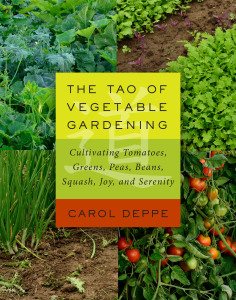The Tao of Vegetable Gardening
Winter trudges along, bringing us snow and sub-zero temperatures, seemingly ignoring the calendar that tells us Spring is officially less than a month away. In between shoveling and carrying firewood I’ve spent considerable time reading this winter. My favorite gardening book this winter is The Tao of Vegetable Gardening: Cultivating Tomatoes, Greens, Peas, Beans, Squash, Joy and Serenity by Carol Deppe (Chelsea Green, $24.95 in paper).
It is rare that a good technical book also deals with joy and serenity, which is part of what distinguishes this book from others. I called Carol Deppe at her home in Oregon and she is as enthusiastic in life as she is in her book. She wrote a chapter in her book called, simply, “Joy.” We are, she asserts, originally hunters and gatherers. Many of us are wired to enjoy gardening – as a way to gather. Recognizing what we love to do, and doing it, makes for a happy person.
The book is full of useful information. When considering a new book I first skim a chapter that is about something I know well. So, for example, if I can learn about tomatoes, I want the book. I did. Carol Deppe has a PhD in biology and has been breeding plants and doing garden research for decades.
So what did I learn about tomatoes? First, that I may be fertilizing them too much, producing big plants but perhaps fewer tomatoes overall than I might. I give each plant a little Pro-Gro (a slow release organic fertilizer) at planting time even though my soil is rich and dark. This year I will plant half with, and half without the fertilizer. And I will keep records.
Carol maintains that irregular watering not only can cause cracking of fruit (which I knew), but that it can also affect flavor, which I did not know. She recommends mulching as a way to keep roots consistently moist, then watering before the soil is dead dry. I mulch, but rarely water – though my soil only dries out in times of drought.
Another factor affecting flavor is temperature. Tomatoes, her book says, taste best if picked in the late afternoon on a sunny day. Cold nights and cool mornings do not help tomato flavor. She often picks 2 to 4 days before full ripeness, and finishes them off indoors where it is consistently warm. Many of the best tasting heirlooms have unripe shoulders even when the rest of the tomato is dead ripe, she wrote, and should be eaten before the shoulders ripen.
She is more attentive to crop rotation than I am. In a small garden there is little space to rotate crops on a 3 year cycle (which she does) – especially since much of what I grow is in the same family: tomatoes, potatoes, peppers (and eggplant, though I don’t grow it). Those plants should not overlap, she says, or be planted in ground that had one of them in the past 2 years.
From the book I learned of some seed companies I haven’t used before and tomato varieties that sound great. From Nichols Garden Nursery (www.nicholsgardennursery.com) I have ordered tomatoes that Carol likes including ‘Legend’, an early tomato (68 days) that produces one-pound tomatoes and is parthenocarpic. That means it can produce fruits without pollination, doing so in cold weather that is not conducive to releasing pollen. She says it is highly tolerant of two late blight strains, too. I never knew there are different strains of the blight.
Nichols Nursery also sells ‘Pruden’s Purple’, ‘Black Krim’ and ‘Geranium Kiss’, others that Carol recommends. ‘Prudens Purple’ is an heirloom that Carol says has flavor as good as ‘Brandywine’, but 2 to 3 weeks earlier. I will try it. ‘Black Krim’, the book explains, reaches full flavor when still half green and firm. If picked when it looks fully ripe, it is overripe, even rotten. I made that mistake once, and never grew it again. ‘Geranium Kiss’, bred by Alan Kapuler (www.peaceseeds.com), is an open pollinated determinate tomato that is very resistant to late blight and produces big clusters of 1 to 2 ounce fruits.
What else did I learn from this book? I learned about ‘Green Wave’ mustard. Carol Deppe broadcasts seed on a weed-free garden bed and then bounces a lawn rake over the soil to disturb the soil and cover the seed. She lets this cooking green grow until it is about 10 inches tall – in about 8 weeks. Then she cuts the top 7 inches off and cooks it up for dinner, or blanches and freezes it. Green Wave is blazingly hot if eaten raw (spicy enough to deter deer), but mild and flavorful after cooking. Seeds are available from her website, www.caroldeppe.com, or from Johnny’s Selected Seeds (www.johnnyseeds.com).
Unlike spinach, Green Wave has real substance after cooking, like kale, so it is good for freezing. And the leaves and stems both are edible when grown in a dense planting (which also shades out weeds). If grown as well spaced out individual plants, the stems are tough and not edible.
The Tao of Vegetable Gardening has a chapter on cooking greens that can be grown like Green Wave, a technique she calls “the Eat-All Garden Greens Method”. The fact that the greens are fast growing means you can harvest 2 crops on the same spot, even here in frigid New England. Carol suggested to me that I plant ‘Green Wave’ after the summer solstice to avoid bolting.
So if you’re still housebound and bored, get a copy of this book and gather some new ideas. It’s good reading in addition to being technically useful. And visit Carol’s website for other seeds, books, articles and further information.
Henry is the author of 4 gardening books, and lectures on gardening. His website is www.Gardening-Guy.com.



